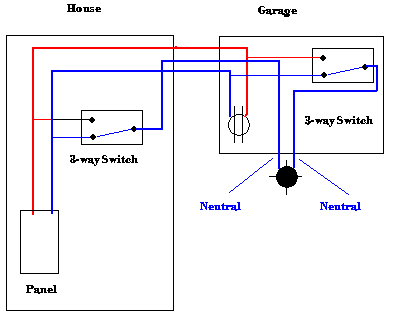flashlight
Senior Member
- Location
- NY, NY
- Occupation
- Electrician, semi-retired
I have heard of some strange and noncompliant schemes for wiring 3-ways, such as the "California" method.
But I had never seen or anticipated what I ran into today in an old Victorian House. Took me a while to piece together what some "electrician" had done, a long time ago:
A staircase with a light, 3-way switches top and bottom. But, no communication between top and bottom switch boxes. No travelers. Instead, the top box and the bottom box each sent one conductor to the load. Not one cable, one conductor. Then, since each box contained a hot (same circuit) and a neutral, they wired the 3-way with the wire going to the load at the common terminal, and the hot and (gasp) the neutral at the traveler terminals.
So, when the switches were in the right position, they had a hot from the top and a neutral from the bottom at the light and Voila ! it lit. Flip one or the other switch and they had either 2 hots or 2 neutrals at the load, so no light. Flip one or the other switch and Voila ! light again. The weird thing about this setup (ok there's lot's of weird things) is that it changed polarity at the load depending on the switch positions. Bizarre and illegal to be sure, but it worked just like a 3-way switch for 50 years.
Has anyone else ever seen this scheme ?
But I had never seen or anticipated what I ran into today in an old Victorian House. Took me a while to piece together what some "electrician" had done, a long time ago:
A staircase with a light, 3-way switches top and bottom. But, no communication between top and bottom switch boxes. No travelers. Instead, the top box and the bottom box each sent one conductor to the load. Not one cable, one conductor. Then, since each box contained a hot (same circuit) and a neutral, they wired the 3-way with the wire going to the load at the common terminal, and the hot and (gasp) the neutral at the traveler terminals.
So, when the switches were in the right position, they had a hot from the top and a neutral from the bottom at the light and Voila ! it lit. Flip one or the other switch and they had either 2 hots or 2 neutrals at the load, so no light. Flip one or the other switch and Voila ! light again. The weird thing about this setup (ok there's lot's of weird things) is that it changed polarity at the load depending on the switch positions. Bizarre and illegal to be sure, but it worked just like a 3-way switch for 50 years.
Has anyone else ever seen this scheme ?



